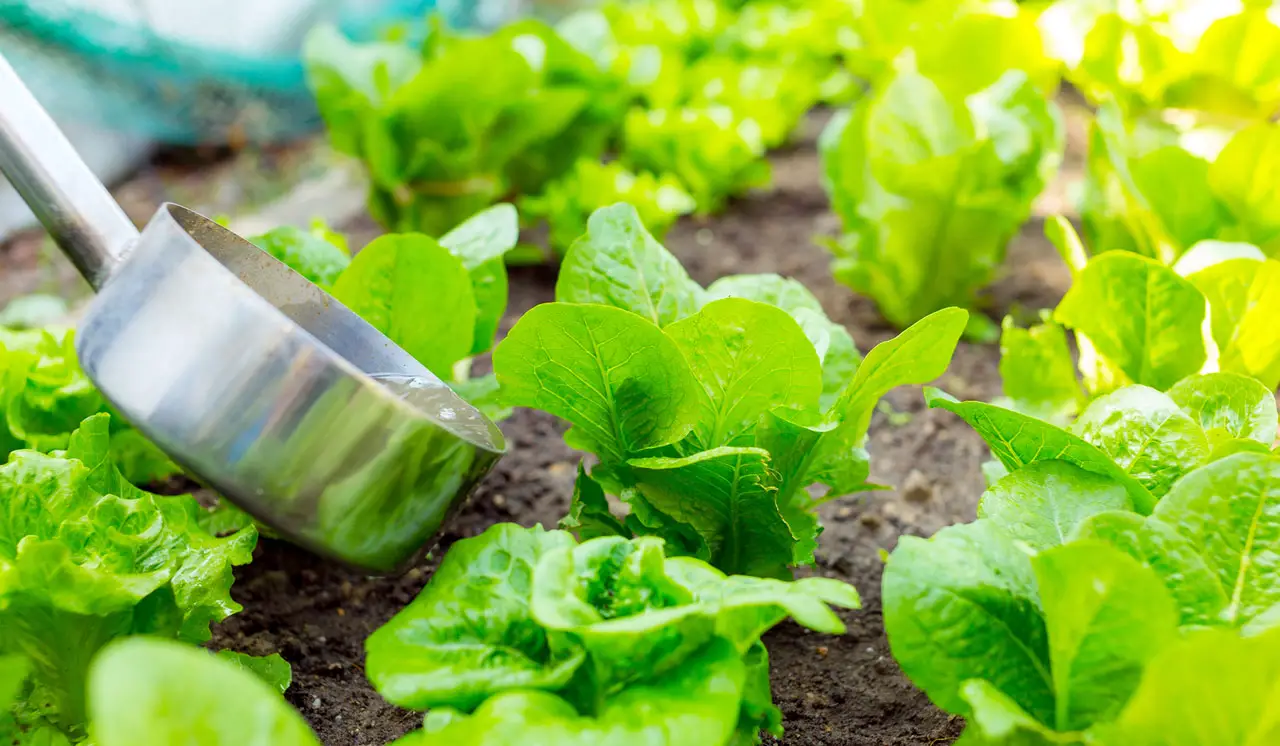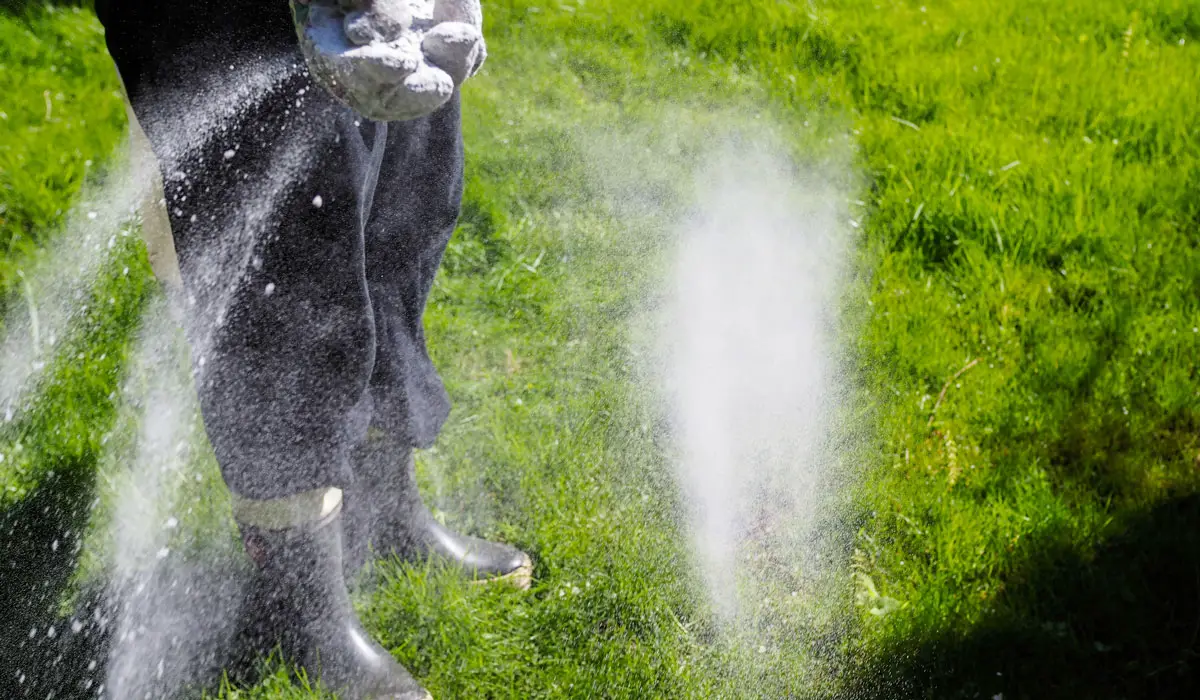What is 16-4-8 fertilizer good for? A Complete Guide

This post follows our research editorial guidelines.

Tinkering with your fertilizer regime is often a tactic used to encourage just the right type of growth. Looking for bigger blooms? Low nitrogen fertilizer is best. Encouraging fat-rich fruit? Try something with lots of phosphorus like bone meal.
But what is a 16-4-8 fertilizer good for? Do they support large flowers or extravagant bounties of fruit or vegetables? And is a 16-4-8 a good choice for lawns?

Table of Contents
What is 16-4-8 fertilizer used for?
Fertilizer with an NPK of 16-4-8 is a strong, complete fertilizer designed for all round use. It supplies (16) nitrogen, (4) phosphorus and (8) potassium in a ratio that favors general growth of foliage, with no special focus on roots, flowers or fruit. It is especially useful for lawns and evergreen shrubs.
What is 16-4-8 fertilizer typically made of?
Those numbers on the front of a typical fertilizer bag or bottle is your window to understanding what exactly is inside. It’s called the NPK ratio, and it will tell you a surprising amount about what that package contains. Let’s take a look!
NPK % Explained
When choosing a commercial fertilizer, one of the most important things to consider is the NPK ratio. This set of numbers tells us how much of the most important three nutrients can be found in the fertilizer, and how much in relation to each other.
The three letters are chemical symbols. N stands for nitrogen, P stands for phosphorus, and K stands for potassium. Between them, they support almost all biological functions in plants, and without them nothing can grow at all.
Plants require those three elements in different quantities, depending on their species and the state of your soils. Most of the time, however, you will need lots of nitrogen, a little phosphorus, and a moderate amount of potassium.
The NPK is a percentage of the overall weight, so you get an idea of not just what’s in it, but how they compare to each other. It also gives us an idea of how potent it is, too.
If you look at a product with an NPK of 16-4-8, it tells us that the product is a strong fertilizer – almost a third of it is an active ingredient, with very little filler. 16% of it is nitrogen, 4% is phosphorus, and 8% is potassium.
Nitrogen

Nitrogen is the cornerstone of plant growth. It’s used to build the chlorophyll present in those vibrant green leaves, and it forms the building blocks of strong stems and stalks. In the roots, it’s present in enzymes that regulate water and nutrient uptake, and it forms the proteins found in seeds. Most plants use quite a lot of it over the course of their lives.
Nitrogen is an abundant element, but it’s hard for plants to get in the quantities they need. It mostly exists as a gas, or bound up in the tissue of other plants and animals. While some plants like peas and clovers can take their own from the air and fix it in the soil, most are dependent on what nitrogen is already there. It gets used fast, and gardeners often use high-nitrogen fertilizers to replace it.
Phosphorous

Phosphorus is another common element, making up a sizable portion of the Earth’s crust. It has the opposite problem to nitrogen – while there’s a lot in the soil, it’s usually locked in too deep, in the form of minerals or stones that plants just can’t access.
Plants desperately need that phosphorus, however. It’s critical to how they harvest energy and store it for later use, from their DNA up. They also use it in early root growth and development of seeds, and without it will have a hard time surviving winters and using their water efficiently.
Flowering also tends to tap out a plants store of this vital nutrient. While people who grow flower gardens love a phosphorus rich fertilizer, it’s also critical to those growing fruit. After all, no flowers means no fruit, either!
You do have to be careful with your phosphorus application. Too much in the soil can cause uptake problems for plants, and excess can be lost through erosion or runoff, entering waterways to d
Potassium
Potassium is a lively part of your garden’s nutritional profile. It zips around inside plants as a charged particle, helping control the flow of fluids within the tissue. It also helps regulate the flow of oxygen and carbon dioxide from the pores of the leaves and triggers enzymes crucial to growth.
Plants need regular top-ups of potassium. It’s highly reactive and tends to get bound up in the soil to just about any other chemical. Its importance also means that it’s still present in every shed leaf or trimmed blade of grass takes removed from your garden. That loss will be felt in time.
Types of 16- 4-8 fertilizer
Spray

Spray fertilizers are generally a liquid that you either add to a spray canister or clip to a hose. It’s applied liberally to the soil, or sprayed over leaves as a foliar drench.
Liquids are fast. They seep into the soil, down to the roots, where they’re readily taken up by the plant and put to quick use. It’s even quicker when applied to the leaves, seeping in through the pores and getting straight to where it’s needed.
On the downside, sprays must be applied with some regularity. That quick uptake also means it doesn’t linger in the soil. It also pays to be careful, because the high nitrogen content can cause chemical burns if applied too heavily.
Sprays are also water soluble and are prone to be washed from the soil in rain or after irrigation, so be careful using sprays around waterways. Fertilizer that winds up in streams can cause algal blooms, killing wildlife.
Spikes
Spikes are long, hard pellets of fertilizer, with a point at one end. They’re designed to be hammered into the soil near the base of a plant, right where the roots are.
It’s an excellent option for large trees and shrubs that require regular nutrition as they tend to be quite slow release, and in general, only need to be applied once a year or so.
On the downside, put them down too close to a root and you risk a chemical burn. They also perform poorly in dry weather, as they require a decent amount of soil moisture to release their load.
Granules
I personally love slow-release granules. They come in a variety of different forms, from finely milled pellets to tiny balls or grains. It’s applied by casting handfuls over the soil itself, or by mixing it into garden beds when they’re tilled or turned over for new plantings.
As the name suggests, they release their bounty slowly, allowing you to fertilize less often, and their formulations tend to prevent runoff or chemical burns. They’re great for lawns, easy to apply, and with an enduring capacity to keep things nice and green.
Water soluble powder
For use in hydroponics, water-soluble powder does exactly what you’d imagine – it dissolved readily in water to be added to a hydroponic solution. It’s a specialist choice with specialist applications.
While it’s tempting to add a water-soluble powder to gardens outdoors, in the interest of maximum uptake, it’s not your best plan. Most will be washed from the soil in the first rain, so leave this one for hydro setups.
Best uses for 16- 4-8 fertilizer
“Shrubs and trees need proper nutrition throughout the growing season to remain healthy and vigorous. Just as you can’t eat enough food on Sunday night to get through the week, we can’t expect our actively growing plants to get by on one yearly fertilizer application either.” Quote: Steve Pettis, Commercial and Consumer Horticulture Agent, North Carolina State University.
Complete fertilizers are excellent all-rounders. They’re a good choice for an annual application to ornamental plants, especially ones that focus most on growing lush leaves. If you’ve got lots of feature foliage, a bit of 16-4-8 each year is a fantastic way to keep things moving along. Shrubs love the stuff, and it’s worth giving them reliable doses for maximum growth.
It’s also great for lawns. Every mowing removes the vital nutrients trapped in the leaves. While you can always compost the clippings or use them to mulch other parts of the garden, the lawn itself will be losing vitality, so regular treatments with a strong fertilizer are required.
When to not use 16-4-8 fertilizer
16-4-8 fertilizers are general purpose, designed to encourage all-round growth. They aren’t great for treating nutrient deficiencies, and they aren’t great for promoting flowers or fruit.
You also need to be careful with plants that are nitrogen or phosphorus sensitive. Many desert and rainforest specialists have evolved to need very little of either of those nutrients and will actually be damaged by an excess in the soil.
When and how often to use 16-4-8 fertilizer

There’s no magic rule that tells you with perfection when to use a complete fertilizer. It depends a lot on what’s growing in your garden, what the climate is like, and how often you remove material, like lawn clippings or leaves.
I’d also strongly suggest you check the state of your soil before applying such a strong product. Soil tests for the big three are cheap to buy and easy to use, no more complicated than dipping a swab in some water. Testing first prevents overdosing any one element and allows you to control precisely how much of any one element winds up in the soil.
For more comprehensive testing, many university extension services will perform free or low-cost soil analysis, providing details including soil pH and the availability of micronutrients not covered by home kits. It’s worth looking into it if you are seeing irregular results or are just scientifically minded, like me! You can look up your closest extension office here.
Is 16-4-8 fertilizer organic?
High-potency fertilizers are almost always synthetic. Each component is made in industrial chemical plants, or mined from mineral deposits and refined before use.
High-potency fertilizers are almost always synthetic. Each component is made in industrial chemical plants, or mined from mineral deposits and refined before use.
This doesn’t make it a bad choice. Synthetics tend to be more precise, with each element added in exact quantities. They’re also concentrated, so you need less of it, applied less often. To be honest, our plants really don’t care where their nitrogen, phosphorus, or potassium is coming from, so long as it keeps coming!
That said, synthetics of all types tend to lack micronutrients like iron, calcium, and magnesium that plants also need to survive. I’d suggest you dose with a rich organic amendment once a season to keep on top of the other minerals and nutrients your garden needs. Kelp meal is a favorite, as are fish meals and emulsions.
Will 16- 4-8 fertilizer make blooms bigger?
A 16-4-8 is a general-use product. The big three ingredients are in proportion to encourage standard growth, with a focus on foliage. It’s not really designed to support big blooms.
Blooms need high phosphorus in their soils in order to get those blooms going. It’s especially true of flowering annuals, as they have a lot of growing to get done in a very short period of time.
Is 16- 4-8 the best fertilizer for lawns?

If you live for your lawn, then a 16-4-8 fertilizer is going to provide fantastic ongoing nutrition to help keep that swathe vibrant and green. Each time a lawn is mowed, those three vital nutrients are removed in abundance. 16-4-8 is a great ratio and strength to keep that lawn growing.
It is very strong, however, so it must be applied to a dry lawn and then watered in. This will prevent chemical burns on the leaves and protect the roots, too.
When should I put 16-4-8 on my lawn?

The frequency of application depends a lot on what kind of fertilizer you opt to use, and what type of grass you’re using. There’s no hard and fast rule – after all, a good lawn is a work of art, and requires a little artistic creativity!
I like slow-release granules. They only need to be added once a year, usually in the fall. They’ll unload their nutrients slowly and surely, giving you more time to enjoy your lawn and less time fussing over it instead.
Liquid fertilizer is more of a seasonal choice. For most species of grasses, once a season during spring, summer, and fall is enough. It’s worth checking what your turf needs specifically, as some hardier species like
Final thoughts
While I’m a big fan of organic and naturally derived options, there’s nothing inherently wrong with a strong, reliable synthetic fertilizer like a 16-4-8. It’s just another tool available to the gardener, and with forethought will help provide that critical fertility needed to keep your garden lush and green.
